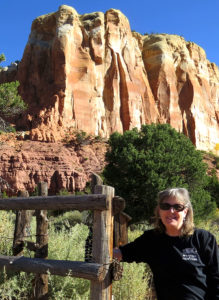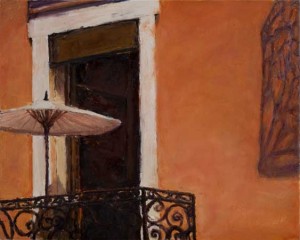Dear Artist,
A subscriber wrote, “Do you ever get stuck? I’m not producing, yet I have endless ideas. I have a studio doggie, take walks in nature, eat well — all the right stuff — but I’m still stuck. There’s some kind of block when I come back to the cabin. Any ideas?”
In addition to the pillars of a studio dog, a daily walk and a quality snack, one other mysterious component could perhaps aid in the recovery of the blocked artist. Mise en place, as it’s called in French kitchens or everything in its place, involves preparing yourself and your ingredients before cooking begins. With veggies chopped, proteins butterflied, relishes ready, sauces de-lumped and seasonings assigned to their tiny bowls, a chef need only work her unique magic. A kind of chef religion, mise en place surpasses mere organizational methodology and soars instead as an ethos for creativity. Working simultaneously as noun and verb, like a walk in nature, mise en place primes the pump for poetry.
Begin with your obvious tools, then add some joy sparkers. If you’re low on joy sparkers, gather some. If staring at a silent loom, remove your current resting idea and begin again with a new and unexpected skein. Expunge the memory of past confidence killers. Take a break from bigger jobs. Fire with impunity the constipating sin of perfection.
When psychologists studied how a person’s environment influences achievement, mise en place emerged as a telling tool. And according to Hip Hop record mogul Dan Charnas, who recently wrote a book on the subject, it goes deeper than cooking. Connecting mise en place to the time-and-effort management tool, “The Eisenhower Matrix,” which explores the difference between the urgent and the important, Charnas has determined that mise en place can enhance corporate ladder climbing and reorganization by slowing down process for efficiency. Shake up the hierarchy! Try it yourself by drawing a couple of columns and listing your own “urgents” and “importants.” “Cooking is like painting or writing a song,” wrote Wolfgang Puck. “Just as there are only so many notes or colors, there are only so many flavors — it’s how you combine them that sets you apart.” (Wolfgang Puck)
Sincerely,
Sara
PS: “I think careful cooking is love, don’t you?” (Julia Child)
Esoterica: Your mise en place can be as simple as stretching your own canvas or making your own gesso mix. While immersed in semi-automatic, pressure-free prep, the mind and body are able to prepare for fresh and enjoyable strokes of brilliance. This prologue to work is also a good time to audit supplies and casually review your personal checklist of banned thoughts. “Once you decide on your occupation, you must immerse yourself in your work,” said Master sushi Chef Jiro Ono. “You have to fall in love with your work. Never complain about your job. You must dedicate your life to mastering your skill. That’s the secret of success and is the key to being regarded honorably.”
Download the new audio book, The Letters: Vol. 1 and 2, narrated by Dave Genn, here. Proceeds of sales contribute to the production of The Painter’s Keys.
“Strategy will compensate the talent. The talent will never compensate the strategy.” (Marco Pierre White)
Featured Workshop
 Ghost Ranch, New Mexico, Darla Bostick, (June and October) workshops
Ghost Ranch, New Mexico, Darla Bostick, (June and October) workshops
Relax, enjoy, create!
Photography/watercolors/acrylics/mixed media. Group activity room (floor to ceiling vista). Ghost Ranch Lodging/meals provided. See why Georgia O’Keeffe loved Ghost Ranch. Each workshop/retreat is different. The June workshop leans heavier on all kinds of materials –textiles and dye, printing, painting, pouring and more! The October workshop combines the media of photography, watercolor, ink, acrylic and more — using watercolor paper, clayboard, etc!
Daily demos, slide presentations, door prizes and optional happy hour. The website shows how I work from Ghost Ranch scenes to finished paintings. www.darlabostick.com
Featured Artist
I am a painter. I am delighted to be a painter.









15 Comments
Love this letter even though I don’t feel stuck at the moment. It really speaks to me, maybe because Of all the cooking references. But yes, setting the pace with semi-automatic, pressure-free mouvements of the body seems to set the mind as well. I couldn’t have found a better wording than “constipating sin of perfection “, this one is priceless. Well done.
I try not to think about it too much. Stuck? Slop some paint around. Eventually it will find an image.
Better yet, sweep the floor, save the paint.
All this letter is good advice that will work. But in addition this, that I have told scores of workshop and studio class participants over the last sixty years: If you’re stuck try painting something old, something you know you can do. I’ve seen this work dozens of times.
When I am getting ready to paint, I slowly clean my palette and replenish my paints, then draw several sketches, then vigorously tint the canvas before moving on. My colleagues don’t know it but I’m thinking out my strategy during this process and when I’m ready I dive right in. And the results are often exhilarating.
Feeling pressure to produce, especially something original from a deeply felt inner source of creation, and feeling this pressure to be a normal or inevitable part of one’s artistic practice, is guaranteed to waste time and materials. I’m convinced that “writer’s block” or “painter’s block” is simply the condition of having nothing to express. Art is the formal expression of conviction; the conviction comes first; one doesn’t go looking for it with brush or pen in hand. Conviction is far more than a few ideas; it is a rare state of inner energy. In its absence, pack up the tools and wait. While waiting, think about and do the million other things that need doing. Better still, don’t think at all (this meditative state is hard to achieve): words come from silence, and paint is brushed onto a blank canvas. If time in the studio seems hard to forego, it can be spent in skill-honing exercises that will be useful if and when one is ready to actualize a long, difficult, often painful inner process.
I recently wrote in my sketchbook- I want to make art like I cook- Every day and to sustain me.
This letter came just at the right time as I am going through somewhat of an incubation period. I don’t call them blocks, the word has such a negative aura, but rather compare these times with something like a birthing process. It’s time for me to gather new tools, open myself up to new ideas, and generally spend a lot of time quietly in my studio playing with those new toys, observing and taking in. “Prep time” or mise en place gives me time to clear my mind and be ready when the muse strikes.
Well said. I can’t decide if it’s laziness or procrastination on my part. I’m an expert on the idea of ‘later’ when my muse returns from holidays. Deadlines spur me on and I can usually accomplish my work by dedicating all my attention and time to the current project. There is no time for my inner crit to interfere so I seem to be more creative.
Like all advice, maybe it will help, maybe not. Miss en place might just end up as more avoidance behavior than a motivator. Depends on how you are wired. For me, I make a comfy chair and tell my ego to go have a seat, relax (and leave me alone for a bit)! Let go of the idea that every time you enter the studio you have to produce something wonderful, salable, or part of some grand series. Just make. Musicians run scales, dancers stretch, visual artists need to warm up, too. Play around. Don’t concern yourself with the outcome. Before you know it, you will be in the flow! Now, if you will pardon me, I have some pillows to fluff for my ego….
Lately I have taken a hiatus from my regular production. Have I stopped producing art? Not really. I completed a nice piece for a fundraiser recently. My church asked me to create a stain glass window (paper) for an event this Sunday. Sara’s article including the woodcuts for “Earthsea” inspired me to do my own lino cuts for a book I am writing for my family about miracles. I have also cut a small lino for the Christmas card this year. Now all I need do is recover from this nasty bit of flu….
I try to remember the fourth rule of success “Don’t be attached to the results.” Journaling helps me get to my truth of the moment, especially when I’m “at sea” or troubled about something. Scribbling w crayons is underrated, with eyes closed if you like. Tiny sketches, thumbnails–maybe at a coffee shop–can be the prelude to what’s next. In the end arid times are vital too. More is going on within than our noisy heads. Robert Bly told the story of fellow poet William Stafford who was asked, “Is it true that you write a poem every day?” Yes, he said. The fellow responded, ‘what do you do when they aren’t so good?’ Stafford replied, ‘I just reduce my standards.’ Stafford worked at an insurance company many of his years but woke at 4:30 every day to write before going to work.
Thanks John, for your comments. I like what you said about Journaling. And about” doing thumbnails and sketches , maybe while at a coffeeshop.” Also, that poet William Stafford “woke up at 4:30 every morning to write before going to work.” Inspiring!
Thanks so much, Sara. The last, small painting shown is in a book “Still Lifes: Techniques and Style” from the Rijksmuseum in Amsterdam. The book gives careful and fascinating analyses of many paintings of the period. They include microscopic thin sections and x-rays of the stratigraphy, pigments used, whether the artist used an imprimatura, whether highlights were reserved, and so on. These artists achieved such remarkable suggestions of texture, volume, and space. Here, rough impastos are used in some highlights, against thin scumbles and smooth layers. The writers note that the variations are organized as an effective compositional devise. So, reinforcing your final quote, “Despite all its complexities, the painting was executed in a concise and efficient manner.”. Looking at the other paintings you’ve shown, I can see the same strategy at work. Dazzling!
what exquisite paintings ,
that kind if paintings I love